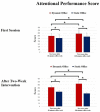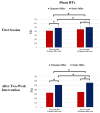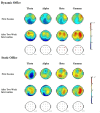Dynamic Office Environments Improve Brain Activity and Attentional Performance Mediated by Increased Motor Activity
- PMID: 31031610
- PMCID: PMC6473162
- DOI: 10.3389/fnhum.2019.00121
Dynamic Office Environments Improve Brain Activity and Attentional Performance Mediated by Increased Motor Activity
Abstract
Current research demonstrates beneficial effects of physical activity on brain functions and cognitive performance. To date, less is known on the effects of gross motor movements that do not fall into the category of sports-related aerobic or anaerobic exercise. In previous studies, we found beneficial effects of dynamic working environments, i.e., environments that encourage movements during cognitive task performance, on cognitive performance and corresponding brain activity. Aim of the present study was to examine the effects of working in a dynamic and a static office environment on attentional and vigilance performance, and on the corresponding electroencephalographic (EEG) brain oscillatory patterns. In a 2-week intervention study, participants worked either in a dynamic or a static office. In each intervention group, 12 subjects performed attentional and vigilance tasks. Spontaneous EEG was measured from 19 electrodes continuosly before, during, and immediately after each experimental condition at the first, and at the last intervention session. Results showed differences in EEG brain activity in the dynamic compared to the static office at the beginning as well as at the end of the intervention. EEG theta power increased in the vigilance task in anterior regions, alpha power in central and parietal regions in the dynamic compared to the static office. Further, increases in beta activity in the attention and vigilance task were shown in frontal and central regions in the dynamic office. Gamma power increased in the attention task in frontal and central regions. After 2 weeks, effects on brain activity increased in the attentional and vigilance task in the dynamic office. Increased theta and alpha oscillations were obtained in anterior areas with higher activity in the beta band in anterior and central areas in the dynamic compared to the static office. EEG oscillatory patterns indicate beneficial effects of dynamic office environments on attentional and vigilance performance that are mediated by increased motor activity. We discuss the obtained patterns of EEG oscillations in terms of the close interrelations between the attentional and the motor system.
Keywords: EEG; dynamic working environment; ergonomics; movement; office.
Figures






Similar articles
-
Exploratory study of the acute and mid-term effects of using a novel dynamic meeting environment (Aeris®) on cognitive performance and neurophysiological responses.Front Hum Neurosci. 2023 Nov 23;17:1282728. doi: 10.3389/fnhum.2023.1282728. eCollection 2023. Front Hum Neurosci. 2023. PMID: 38077188 Free PMC article.
-
Intracerebral ERD/ERS in voluntary movement and in cognitive visuomotor task.Prog Brain Res. 2006;159:311-30. doi: 10.1016/S0079-6123(06)59021-1. Prog Brain Res. 2006. PMID: 17071240
-
Post-task Effects on EEG Brain Activity Differ for Various Differential Learning and Contextual Interference Protocols.Front Hum Neurosci. 2018 Jan 31;12:19. doi: 10.3389/fnhum.2018.00019. eCollection 2018. Front Hum Neurosci. 2018. PMID: 29445334 Free PMC article.
-
The functional significance of delta oscillations in cognitive processing.Front Integr Neurosci. 2013 Dec 5;7:83. doi: 10.3389/fnint.2013.00083. Front Integr Neurosci. 2013. PMID: 24367301 Free PMC article. Review.
-
The brain in motion-cognitive effects of simultaneous motor activity.Front Integr Neurosci. 2023 May 25;17:1127310. doi: 10.3389/fnint.2023.1127310. eCollection 2023. Front Integr Neurosci. 2023. PMID: 37304529 Free PMC article. Review.
Cited by
-
The Effect of Differential Repeated Sprint Training on Physical Performance in Female Basketball Players: A Pilot Study.Int J Environ Res Public Health. 2021 Nov 30;18(23):12616. doi: 10.3390/ijerph182312616. Int J Environ Res Public Health. 2021. PMID: 34886342 Free PMC article.
-
Unveiling the acute neurophysiological responses to strength training: An exploratory study on novices performing weightlifting bouts with different motor learning models.Biol Sport. 2024 Mar;41(2):249-274. doi: 10.5114/biolsport.2024.133481. Epub 2023 Dec 18. Biol Sport. 2024. PMID: 38524821 Free PMC article.
-
A novel motorized office chair causes low-amplitude spinal movements and activates trunk muscles: A cross-over trial.PLoS One. 2023 Dec 22;18(12):e0294778. doi: 10.1371/journal.pone.0294778. eCollection 2023. PLoS One. 2023. PMID: 38134012 Free PMC article.
-
Exploratory study of the acute and mid-term effects of using a novel dynamic meeting environment (Aeris®) on cognitive performance and neurophysiological responses.Front Hum Neurosci. 2023 Nov 23;17:1282728. doi: 10.3389/fnhum.2023.1282728. eCollection 2023. Front Hum Neurosci. 2023. PMID: 38077188 Free PMC article.
References
-
- Ayaz H., Dehais F. (2019). Neuroergonomics: The Brain at Work and Everyday Life. 1st Edn. Elsevier: Academic Press; Available online at: https://www.sciencedirect.com/book/9780128119266/neuroergonomics. [Accessed on March 19, 2019].
-
- Brickenkamp R., Schmidt-Atzert L., Liepmann D. (2010). d2-R. Test d2-Revision. Aufmerksamkeits- und Konzentrationstest. Göttingen: Hogrefe.
LinkOut - more resources
Full Text Sources

